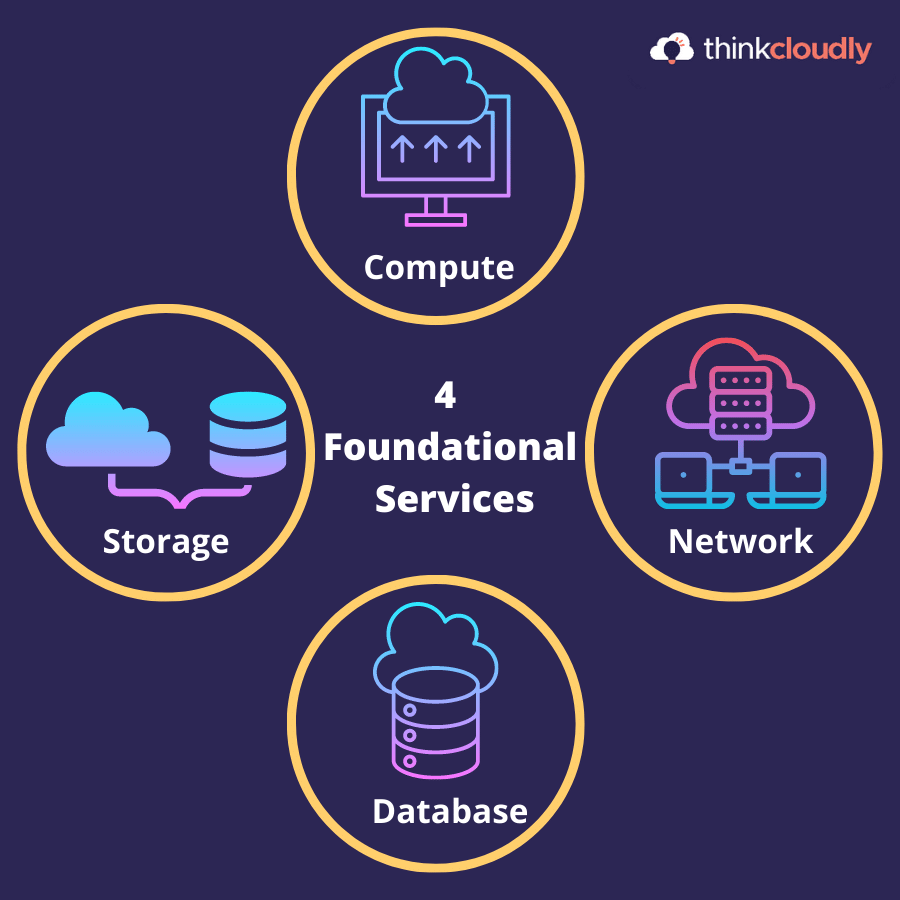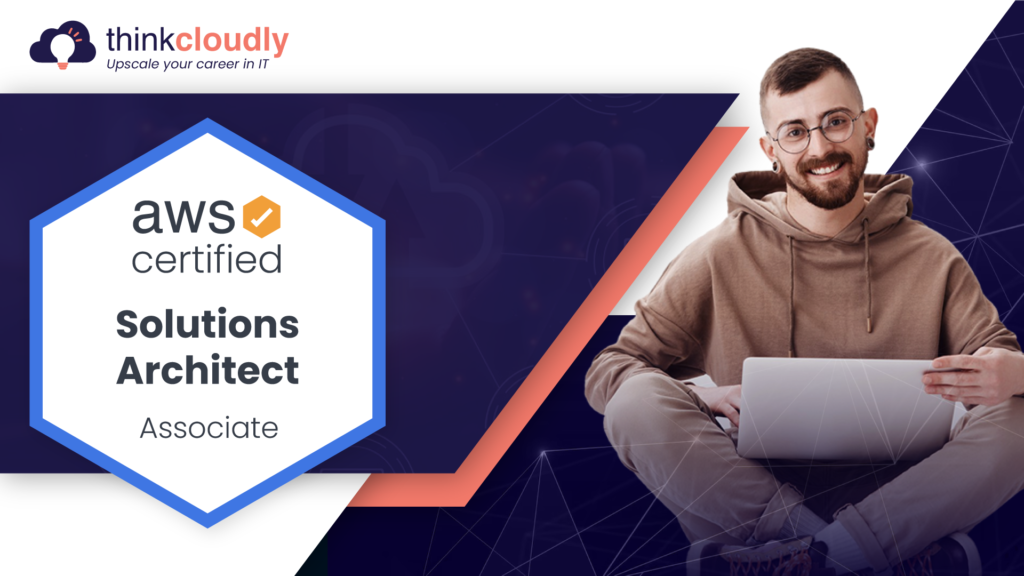AWS, or Amazon Web Services, has come a long way since the day it was born in 2006. Back then, they only had what they referred to as the four foundational services—Compute, Storage, Networking, and Database. The company has since added numerous other services, but these four are still the most essential, providing your AWS account with the fundamentals needed to scale up to meet your needs. Here’s a quick overview of the four foundational services of AWS.

Let’s start with the basic things..
AWS Basics: Foundation Services & Fundamentals
Building a robust understanding of the AWS cloud begins with exploring the realm of “AWS foundation services.” These services serve as the bedrock of AWS, offering essential tools for creating and managing various resources. For those seeking comprehensive knowledge, the “AWS Fundamentals Specialization” provides an ideal pathway. This specialized learning track equips individuals with the fundamental skills needed to navigate AWS services confidently. From computing and storage solutions to networking and security features, mastering these foundation services lays a strong groundwork for harnessing the full potential of the AWS cloud platform.
What is AWS Web Services?
Amazon Web Services (AWS) is a cloud platform that provides customers with a wide range of services to help them build, run, and scale their businesses. These services fall into four main categories: computing, storage, database, and networking.
Having seen considerable growth, AWS offers users a scalable, accessible way to create sophisticated applications by leveraging AWS’ vast selection of cloud-based products and solutions. To learn more about AWS check what is AWS.
How does AWS Cloud work?
AWS provides Cloud Computing services that enable users to rent their services, allowing for seamless access to many different business models. A large number of sites and apps choose to let AWS host them for a variety of reasons including its lower cost, greater efficiency, and better security.
Boost your earning potential with AWS expertise. Explore our certified AWS Courses for a high-paying career
What are the different types of Cloud Computing?
Cloud computing can be divided into three main categories: Infrastructure as a Service (IaaS), Platform as a Service (PaaS), and Software as a Service (SaaS).
- IaaS is a type of cloud computing that delivers computer infrastructure, typically a platform virtualization environment, as a service.
- PaaS is a type of cloud computing that delivers a platform on which software can be developed, tested, and deployed.
- SaaS is a type of cloud computing that delivers software as a service.
So now I hope you got a quick glance at AWS cloud computing. If you want to learn more about it read our blog what is AWS?
Build Your Career as a
AWS Solution Architect
- Live Projects
- Resume / Interview Preparation

What are the Four Foundational Services of AWS?
AWS provides four services that form the foundation of any cloud deployment: computing, storage, networking, and database. Each service is designed to offer high availability and scalability so that you can build a robust and reliable application in the cloud. Let’s take a closer look at each service and know how it can benefit your business.
In 2024, AWS continues to thrive as a leading cloud provider, offering a robust set of services that serve as the cornerstone of its cloud ecosystem. These Four Foundational Services of AWS, often referred to as the bedrock of the AWS platform, include Compute, Storage, Database, and Networking. These services collectively provide the building blocks for virtually any cloud-based application or infrastructure, enabling businesses to harness the power of AWS Platform as a Service (PaaS) while establishing a solid Cloud Foundation AWS. AWS Compute services such as EC2 offer scalable computing power, while Storage services like S3 provide flexible data storage options. AWS’s Database offerings, like RDS and DynamoDB, cater to a variety of data management needs, and Networking services ensure seamless connectivity and security. These foundational services not only form the backbone of AWS but also empower organizations to innovate and scale their operations in the cloud with confidence.
Compute
Compute resources are the brains and processing power needed by applications and systems to carry out computational tasks. So Compute is essentially the same as common server components, such as CPU and RAM, which many of you are already familiar with. Physical servers within a data centre are considered compute resources as they may contain multiple CPUs and tons of RAM to process instructions given by the operating system and applications. Below are the computing services provided by AWS:
AWS EC2
Amazon Elastic Compute Cloud (EC2) is a web service that provides secure, resizable computing capacity in the cloud. It is designed to make web-scale cloud computing easier for developers. Amazon EC2’s simple web interface allows you to obtain and configure capacity with minimal friction. It provides you with complete control of your computing resources and lets you run on Amazon’s proven computing environment.
You can use Amazon EC2 to launch as many applications as you want—whether they’re running on Linux, Windows, or Oracle—and manage all of them using a single API call. And since it’s scalable and pay-as-you-go, Amazon EC2 reduces up-front investment costs while providing flexibility and control over resource allocation.
With Amazon EC2, there are no upfront investments required – instead, you simply pay per hour of usage. So if your application needs more computing power, you can increase capacity right away without having to wait for an IT department to order and install new hardware.
AWS Lambda
Amazon Web Services Lambda is a serverless computing platform that runs your code in response to events and automatically manages the underlying compute resources for you. You can use Lambda to build applications that respond quickly to new information. Plus, Lambda is scalable so you can process events as they happen, without having to provision or manage any servers.
For example, an e-commerce company might use Lambda functions to analyze incoming customer data for marketing purposes. Or an enterprise IT organization might use it to keep their systems up-to-date with security patches and fixes.
With Lambda, you don’t have to worry about capacity planning because it scales seamlessly along with your needs. It also lets developers spend more time on development and less time on managing infrastructure – perfect for fast-moving startups!
AWS Elastic Beanstalk
Amazon Web Services Elastic Beanstalk is a platform as a service (PaaS) that streamlines the process of deploying and scaling web applications and services developed with popular programming languages and frameworks. Elastic Beanstalk provides pre-configured platforms for programming languages like Java, .NET, PHP, Node.js, Python, and Ruby.
You can simply upload your code and Elastic Beanstalk automatically handles the deployment, from capacity provisioning, load balancing, and auto-scaling to application health monitoring. Elastic Beanstalk’s no configuration mode allows you to deploy an application without worrying about the details, such as what type of environment it needs or where it should be deployed.
It also includes many features to allow developers to focus on their code rather than administrative tasks, including integrations with other AWS products. These features include Auto Scaling and Load Balancing which will scale up servers when traffic increases and automatically distribute incoming requests across all servers.
Network
Peer-to-peer networking occurs when two or more devices share data with one another without using an intermediary device like a server. Mesh networks are built for redundancy and consist of multiple paths for messages to travel between nodes.
Amazon Route 53
One thing that sets Amazon Route 53 apart from other DNS services is the inclusion of various geo and routing features. An example of this would be Latency Based Routing which routes traffic depending on its proximity to the desired destination, or you could also do IP Prefix.
You could also set up Dynamic Record Sets which will automatically create records if they don’t exist when queried so there’s no need to maintain static records. Or maybe Reverse DNS Lookups which will map an IP address back to a domain name for security purposes. Other products that work well with Amazon Route 53 include AppStream 2.0, AppSync, and CloudFront CDN.
AWS VPC
VPC provides you with complete control over your virtual networking environment, including a selection of your own IP address range, creation of subnets, and configuration of route tables and network gateways. In addition, you can launch AWS resources into a VPC to provide isolation from the rest of the AWS cloud.
Cloud Storage
Amazon S3
It provides a simple web services interface that can be used to store and retrieve any amount of data, at any time, from anywhere on the web. It gives customers complete control over their data by providing robust access controls and multiple redundant storage facilities with no single point of failure. You only pay for what you use. Amazon S3 makes it easy to serve your content quickly and reliably, even when some parts of your infrastructure don’t function properly or become unavailable.
Amazon Glacier
With Amazon Glacier, customers pay only for what they use. Storage prices start as low as $0.01 per gigabyte per month; retrieval pricing starts at $0.001 per gigabyte. That’s considerably less than most tape libraries, so storing your archived data with us could save you money over time!
Database
Cloud databases are a new breed of database that offers all the benefits of the cloud: elasticity, scalability, and cost-effectiveness. Just like traditional databases, they can be used to store data, but they also come with a few key differences. For one, cloud databases are designed to be scalable and highly available, so they can handle large workloads without going down.
They’re also automatically replicated across regions for high availability and seamless disaster recovery. Unlike most traditional databases, which require you to set up hardware yourself in order to grow your compute power, these services are preconfigured for auto-scaling as needed so you don’t have to worry about capacity planning. Plus, there’s no upfront cost for these powerful services – pay only for what you use when you need it.
Let’s take a look at the DB services provided by AWS Cloud.
Amazon RDS (Relational Database Service)
Amazon RDS is a managed relational database service that makes it easy to set up, operate, and scale a relational database in the cloud. It provides cost-effective and resizable capacity while automating time-consuming administration tasks such as hardware provisioning, database setup, patching, and backups.
Amazon RDS is available on several database instance types – optimized for memory, performance or I/O – and provides you with six familiar database engines to choose from, including Amazon Aurora, MySQL, MariaDB, Oracle Database, Microsoft SQL Server, and PostgreSQL. With these features, Amazon RDS gives you maximum flexibility and control over your data.
You can also use various deployment models for Amazon RDS, which include managed services (where we handle everything) and shared services (where you maintain ownership).
Amazon DynamoDB (Non-Relational Database)
Amazon DynamoDB is a non-relational database that delivers single-digit millisecond performance at any scale. It’s a fully managed, multi-region, multi-master, durable database with built-in security, backup and restore, and in-memory caching for internet-scale applications. DynamoDB can handle more than 10 trillion requests per day and can support peaks of more than 20 million requests per second.
You don’t need to worry about backups or recovery because DynamoDB automatically provides linear scalability, high availability, durability, and predictable performance. As your data grows you can use Provisioned Capacity to automatically increase storage capacity without downtime as well as Auto Scaling to adjust your provisioned throughput capacity up or down based on usage demands.
Elasticity allows you to store and retrieve unlimited amounts of data while paying only for what you use (since there is no minimum fee). With Amazon ElastiCache, access in-memory cache anywhere in the world to power web, mobile, and IoT applications—without having to set up servers.
As you know the four most important AWS fundamental services now we can explore the AWS Data Ingestion Services.
Conclusion:
The four foundational services of AWS are Amazon Elastic Compute Cloud (EC2), Amazon Simple Storage Service (S3), Amazon DynamoDB, and Amazon Route 53. These services provide the building blocks that you can use to create applications in the cloud. Each service is designed to be highly scalable and fault-tolerant, so you can focus on building your application without having to worry about infrastructure.
Check out our AWS cloud practitioner certification course if you’re interested in cloud computing, or read our other blog posts on different AWS and Azure services.










